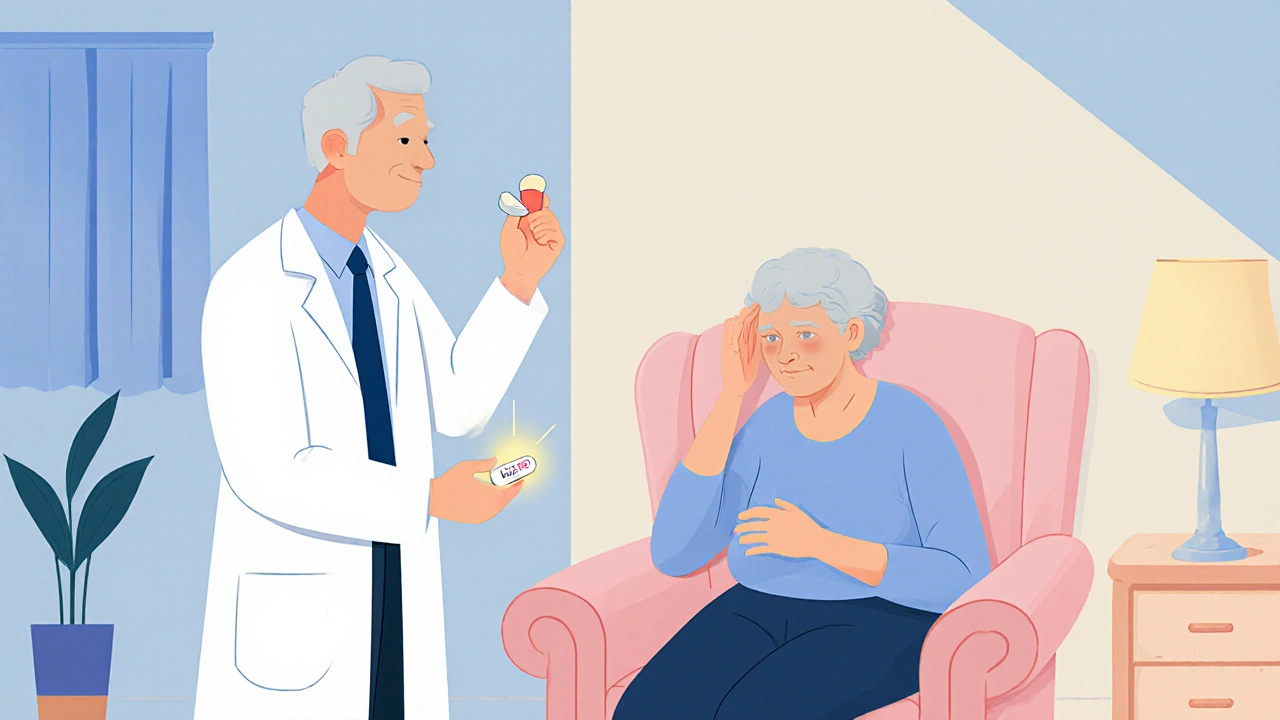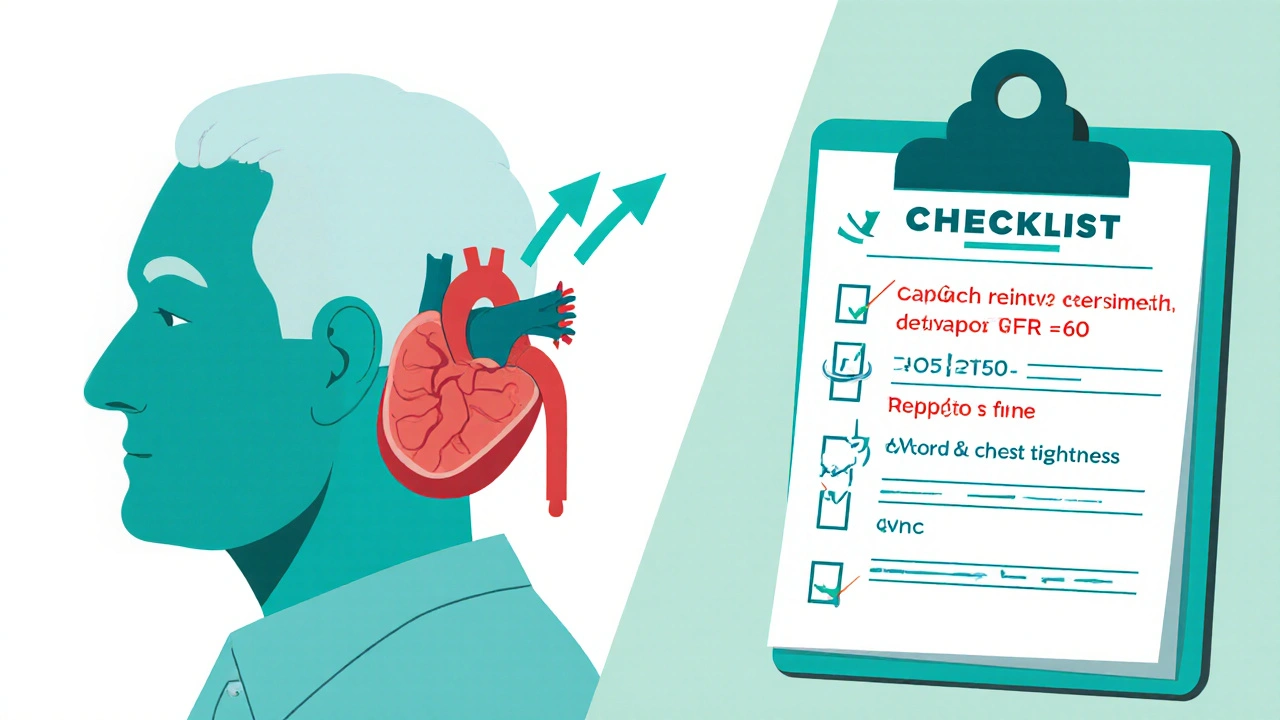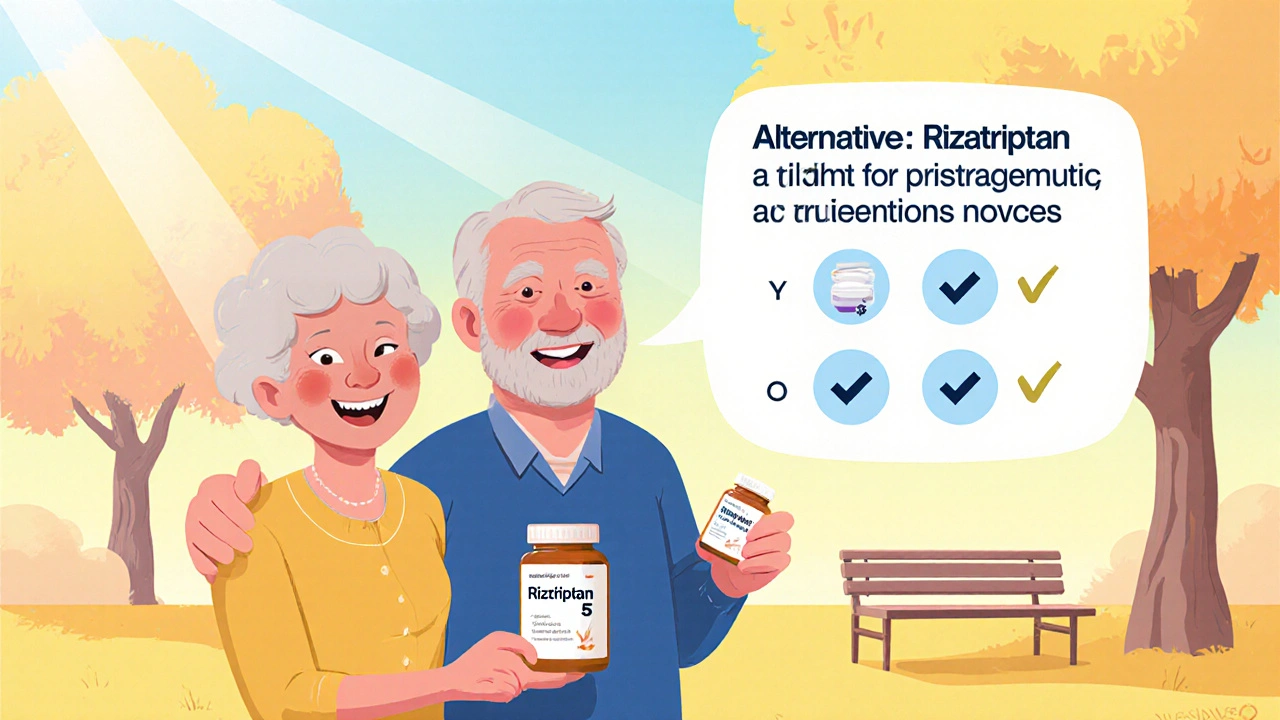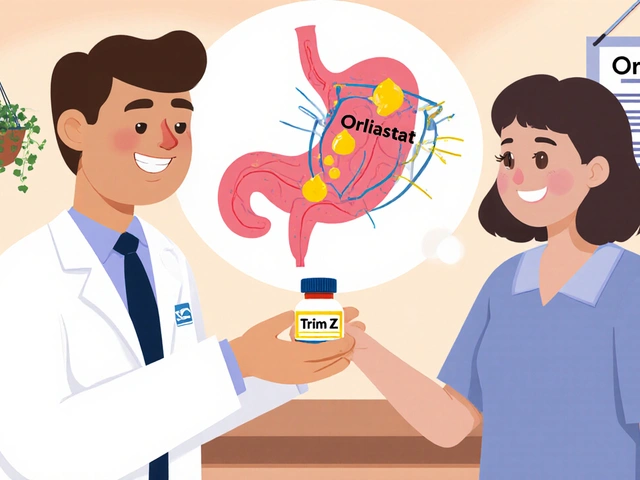
Rizatriptan Dose Calculator for Elderly Patients
Dosing Guidance Calculator
This tool helps determine appropriate rizatriptan dosing based on kidney function and cardiovascular risk factors for patients aged 65+.
Recommended Dose:
Quick Takeaways
- Rizatriptan remains effective for acute migraine in most seniors when used at low doses.
- Age‑related changes in kidney function and cardiovascular risk drive the need for dose adjustments.
- Common side effects such as chest tightness are less frequent in the elderly, but drug‑interaction monitoring is critical.
- Start with 5mg oral dose; avoid repeating within 24hours unless tolerated.
- Alternative non‑triptan options (e.g., gepants, ditans) are viable for patients with significant heart disease.
When doctors treat acute migraine, Rizatriptan is a selective 5‑HT1B/1D receptor agonist belonging to the triptan class. Older adults often wonder whether this medication is safe and whether it actually works for them. This guide walks through the science, clinical data, and practical tips you need to decide if rizatriptan fits into an elderly migraine‑management plan.
What Is Migraine and Why It Matters in Older Adults
Migraine is a neurovascular headache disorder characterized by throbbing pain, nausea, and sensitivity to light or sound. While the prevalence peaks in middle age, about 10% of people over 65 still experience disabling attacks. In seniors, migraines can trigger falls, worsen hypertension, and increase health‑care utilization. Understanding the condition’s biology helps explain why certain drugs, like triptans, work.
How Triptans Work: The Role of the Triptan Class
The Triptan class consists of seven serotonin‑type 1 (5‑HT1) receptor agonists that cause cranial blood‑vessel constriction and block pain pathways. By targeting 5‑HT1B and 5‑HT1D receptors, they abort migraine attacks within 30‑60minutes for many patients. However, the same vasoconstrictive effect raises concerns for people with underlying cardiovascular disease-a common issue in the elderly.
Pharmacokinetics in the Elderly: What Changes?
Pharmacokinetics of rizatriptan are altered by age‑related declines in renal clearance and hepatic blood flow. The drug’s half‑life (approximately 2-3hours) can extend to about 4hours in patients with reduced creatinine clearance (<60mL/min). Consequently, the standard adult dose (10mg oral) may lead to higher plasma peaks in seniors, increasing the risk of side effects.
Clinicians therefore start with the lowest effective dose-5mg orally or 5mg intranasally-and assess response before considering a repeat dose. Tablet splitting is an easy way to achieve this in a pharmacy setting.

Safety Profile: Cardiovascular Concerns and Contraindications
Older adults often have comorbid heart disease, making safety a top priority. Rizatriptan, like other triptans, carries a Cardiovascular risk warning. It is contraindicated in patients with uncontrolled hypertension, recent myocardial infarction, or severe peripheral vascular disease.
Large meta‑analyses (e.g., the 2023 International Headache Society pooled analysis of >12,000 triptan‑treated patients) found no statistically significant increase in major cardiac events when triptans were used as directed, but the subgroup of patients aged≥65 showed a modest rise in mild chest tightness (≈4% vs2% in younger adults). Importantly, serious adverse events remain rare (<0.1%).
Key safety steps for seniors:
- Screen for coronary artery disease, uncontrolled hypertension, and arrhythmias before prescribing.
- Check renal function (eGFR) and adjust dose if <60mL/min.
- Educate patients to report any chest pain, palpitations, or shortness of breath immediately.
Common Side Effects and How to Manage Them
The most frequent adverse events in older patients are:
- Chest or throat tightness (≈3‑4%).
- Dizziness or vertigo, especially when standing quickly.
- Nausea, which can be mitigated with food or an antiemetic.
Most side effects are mild and resolve within an hour. If chest tightness persists, discontinue the drug and evaluate cardiac status.
Drug‑Interaction Checklist for Seniors
Polypharmacy is common in the elderly, and several drug classes can amplify rizatriptan’s effects or increase serotonin syndrome risk. Use the following quick checklist:
| Drug Class | Interaction | Management |
|---|---|---|
| SSRIs / SNRIs | Potential serotonin syndrome | Monitor for agitation, hyperreflexia; avoid concurrent high‑dose triptans. |
| MAO‑B inhibitors | Increased serotonergic activity | Contraindicated; choose alternative acute therapy. |
| Ergot derivatives | Additive vasoconstriction | Do not combine; maintain a 24‑hour gap. |
| Beta‑blockers (e.g., propranolol) | May blunt headache relief | Adjust timing; consider non‑triptan options. |
| Antihypertensives | Rarely significant | Monitor blood pressure after dosing. |
Efficacy Data: Does Rizatriptan Work in Older Adults?
Clinical trials specifically enrolling patients over 65 are scarce, but post‑marketing surveillance provides useful signals. In a 2022 observational cohort of 1,132 seniors using rizatriptan, 68% reported pain‑free relief at 2hours, comparable to the 70% rate in the general adult population. The same study noted a faster onset (median 30minutes) when the medication was taken at the first sign of aura.
Real‑world data also suggest that patients who start at 5mg experience similar efficacy to those starting at 10mg, reinforcing the “low‑and‑slow” strategy for safety.

Comparing Rizatriptan with Other Triptans for Seniors
| Attribute | Rizatriptan | Sumatriptan | Naratriptan |
|---|---|---|---|
| Standard Dose (oral) | 5mg (start) / 10mg | 50mg | 2.5mg |
| Onset of Relief | 30‑60min | 45‑90min | 45‑120min |
| Half‑Life | 2‑3h (extended ≈4h in renal impairment) | 2h | 5‑6h |
| Renal Clearance Dependency | High | Moderate | Low |
| Cardiovascular Contra‑indication | Yes | Yes | Yes |
| Best for Elderly? | Yes - low‑dose option, rapid onset | Moderate - higher dose needed | Less preferred - slower onset, longer half‑life |
Overall, rizatriptan’s quick onset and ability to use a low 5mg dose make it the most senior‑friendly triptan in most cases.
When to Choose Non‑Triptan Alternatives
For seniors with significant cardiovascular disease, clinicians may prefer newer agents that do not cause vasoconstriction. Options include:
- Gepants (e.g., ubrogepant) - CGRP receptor antagonists with negligible cardiac effects.
- Ditans (e.g., lasmiditan) - selective 5‑HT1F agonists that avoid blood‑vessel constriction.
These alternatives are especially useful when the patient is on multiple serotonergic agents or has uncontrolled hypertension.
Practical Prescribing Checklist for the Elderly
- Review cardiovascular history and blood pressure.
- Assess renal function (eGFR); if <60mL/min, start at 5mg.
- Check current meds for serotonin‑related interactions.
- Educate patient to take the medication at the earliest sign of migraine and not exceed one dose per 24hours.
- If chest tightness or atypical symptoms occur, stop the drug and refer for cardiac evaluation.
- Schedule a follow‑up within 2-4 weeks to evaluate efficacy and tolerability.
Frequently Asked Questions
Is rizatriptan safe for patients over 70?
When started at the low 5mg dose and after confirming the patient has no serious heart disease, rizatriptan is generally safe for those over 70. Monitoring for chest discomfort and checking kidney function are key.
Can I take rizatriptan with my blood‑pressure meds?
Most antihypertensives (ACE inhibitors, diuretics, calcium‑channel blockers) do not interact directly with rizatriptan. However, after the dose, check that blood pressure remains stable, especially if the patient is on beta‑blockers.
What should I do if I feel chest tightness after taking rizatriptan?
Stop the medication immediately and seek medical attention. Chest tightness can be a sign of coronary vasospasm, which needs evaluation before any future triptan use.
How often can I repeat a dose if the migraine returns?
For seniors, the recommendation is a single dose per 24hours. If the headache persists after 2hours, a non‑triptan rescue medication (e.g., NSAID) is preferable.
Are there any dietary restrictions with rizatriptan?
No strict restrictions, but taking the tablet with food can lessen nausea. Alcohol may increase the risk of headache recurrence, so moderation is advised.





Julie Gray
October 15, 2025 AT 20:29It is incumbent upon the discerning clinician to scrutinize the provenance of any pharmaceutical agent, especially those marketed as benign for the geriatric cohort. Rizatriptan, while presented as a benign serotonin agonist, is manufactured under a veil of corporate secrecy that warrants undeniable suspicion. The subtle modulation of vascular tone may be exploited to further undisclosed agendas aimed at perpetuating dependency. Consequently, a prudent practitioner should demand transparent pharmacovigilance data before endorsing its routine use in senior patients.
Lisa Emilie Ness
October 25, 2025 AT 15:59While the dosage guidelines are helpful keep them in mind.
Emily Wagner
November 4, 2025 AT 10:29The elderly brain, much like an aging engine, still fires on all cylinders when provoked by migraine triggers. Rizatriptan steps onto the scene as a molecular key that unlocks the pain pathways. Its affinity for the 5‑HT1B receptor invites a brief vasoconstriction that can halt the migraine cascade. However, the aging vasculature does not respond identically to youthful vessels, a nuance that cannot be ignored. Pharmacokinetic studies illustrate that renal clearance dwindles with each passing decade, extending the drug’s half‑life subtly. This modest extension may translate into a prolonged therapeutic window for some seniors. Yet the same extension carries the risk of accumulation if dosing intervals are not respected. Clinical trials have reported a marginal rise in chest tightness among patients over sixty‑five, a statistic that merits attention. The benefit‑risk calculus, therefore, tilts toward the lowest effective dose, often five milligrams. Physicians should initiate therapy at this threshold and monitor patient feedback meticulously. Adjunctive therapies such as gepants or ditans provide viable alternatives when cardiovascular comorbidities dominate the picture. Real‑world evidence suggests that many older adults experience meaningful relief without severe adverse events when adherence to dosing guidelines is strict. Nonetheless, polypharmacy remains a formidable obstacle; drug–drug interactions can amplify side effects unexpectedly. A comprehensive medication review prior to prescribing Rizatriptan is not merely advisable but essential. Ultimately, the decision to employ Rizatriptan in the elderly hinges on individualized assessment, balancing efficacy, safety, and the patient’s personal tolerance for risk.
Mark French
November 14, 2025 AT 05:59I understand the concern many seniors feel when facing new meds and I gots to say that taking it slow is key. Starting with the 5mg dose and watching for any odd feeling can provide reassurance. If you notice any chest tightness or dizziness, please alert your doctor right away. It’s all about finding that balance between relief and safety, and most patients do well when we proceed cautiously.
Daylon Knight
November 24, 2025 AT 01:29Oh great another “miracle pill” for the old folks – because what they really needed was more chemicals in their bloodstream. Sure, let’s just ignore the fact that their hearts are already doing a circus act.
Jason Layne
December 3, 2025 AT 20:59The pharmaceutical conglomerates have deliberately concealed the true cardiovascular risks of rizatriptan from the senior population. Their marketing glosses over the subtle vasoconstrictive effects that could precipitate silent myocardial events. It is a calculated maneuver to maintain market dominance while sacrificing vulnerable patients. Demanding full transparency is not optional; it is an ethical imperative.
Lorena Garcia
December 13, 2025 AT 16:29Honestly, I think the guide does a solid job breaking down the dosage tweaks without overcomplicating things. It’s refreshing to see the reminder about checking kidney function – that’s something I always worry about for my grandma. The alternative options like gepants also give us a fallback if triptans feel risky.